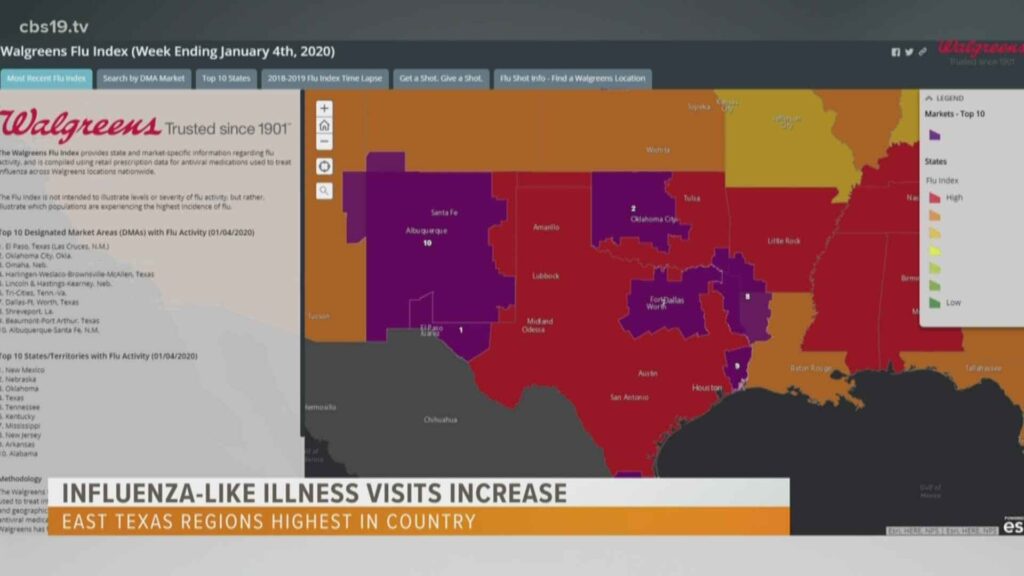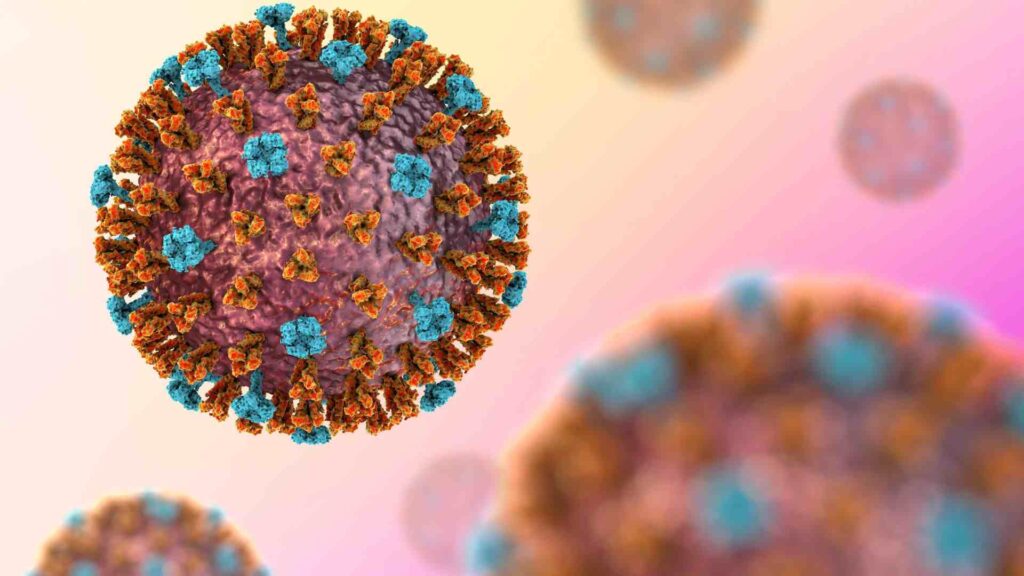Flu season in Texas is a yearly concern, bringing waves of illness that affect thousands. In Texas, flu season typically begins in October and can last until May. However, the peak months for flu cases are usually January and February, when colder weather keeps people indoors, allowing the flu virus to spread more easily.
While October is considered the official start, flu activity can vary depending on factors like temperature changes and population immunity. Some years, cases might start appearing as early as September, while others could peak later in March.
Check Out The Flu Activity In Texas!
The Texas Department of State Health Services (DSHS) plays a key role in tracking flu activity. They operate a surveillance network of doctors and hospitals reporting flu cases across the state. This system ensures that Texans get real-time updates about flu trends through the Weekly Flu Surveillance Report, which outlines:

- The types of flu viruses circulating
- The number of reported cases
- Regions most affected
In my opinion, this proactive approach by DSHS helps Texans prepare better for flu season. By staying updated with these reports, you can plan vaccinations and take preventive measures early.
When is Flu Season Most Severe in Texas?
The severity of flu season in Texas can vary each year. The flu is usually at its worst between January and February due to colder temperatures. During these months, people spend more time indoors, making it easier for the flu virus to spread.
However, how bad the flu season gets depends on:
- How well the flu vaccine matches the circulating strains
- How many people get vaccinated
- The presence of other respiratory viruses
It’s important to note that flu severity also depends on individual health conditions. For some, the flu might just cause mild symptoms, while for others, it can be life-threatening.
Key Flu Symptoms to Watch For!
Recognizing flu symptoms early can help you recover faster and prevent spreading it to others. The flu often comes on suddenly and can include:
- Fever or chills
- Cough and sore throat
- Runny or stuffy nose
- Muscle or body aches
- Headaches and fatigue
- Nausea, vomiting, and diarrhea (especially in children)
Some people might have the flu without showing symptoms, which makes it harder to contain. If you start feeling ill, it’s best to rest, stay hydrated, and consult a healthcare provider if symptoms worsen.
Emergency Care Tips for Flu Season in Texas
While most flu cases resolve with rest and care at home, some symptoms require immediate medical attention. You should seek urgent care if you experience:
- Shortness of breath
- Chest pain
- Persistent dizziness
- Seizures
- High fever that doesn’t improve
For children, emergency warning signs include:
- Fast or troubled breathing
- Bluish lips or face
- Not waking up or interacting
- Severe muscle pain or dehydration
Early medical care can prevent severe complications like pneumonia or hospitalization.
How to Prevent the Flu in Texas
Staying flu-free during Texas’s flu season isn’t impossible. With a few smart strategies, you can reduce your chances of getting sick:
Get a Flu Shot:
The flu vaccine is your best defense. It reduces the risk of illness by 40–60% and prevents severe complications.Flu vaccines are updated annually to match the most common circulating strains.
Practice Good Hygiene:
Wash hands regularly with soap and water. Avoid touching your face, especially the nose, mouth, and eyes.
Avoid Close Contact with Sick People:
Stay away from people showing flu symptoms. If you’re sick, stay home to prevent spreading the virus.
Boost Your Immune System:
Maintain a balanced diet, stay hydrated, and get enough sleep. Regular exercise can also help your immune system stay strong.
When to Get a Flu Shot in Texas
Timing your flu shot is crucial. The best time to get vaccinated in Texas is September or October, just before the flu season starts. This allows your body enough time (about two weeks) to develop antibodies and provide protection throughout the peak months.
However, if you miss this window, getting vaccinated later is still beneficial, even in January or February. The flu season can last until May, so late vaccination still offers protection.
When is Flu Season Over in Texas?
Flu season in Texas generally ends by May, but the exact timing can differ each year. Warmer temperatures usually reduce flu activity, as the virus spreads less easily.

However, some late-season cases can still occur, especially in large gatherings or among vulnerable groups. It’s wise to continue practicing good hygiene and staying cautious even as flu activity declines.
Have you explored? What Is Tattoo Flu – What do y’all do?
Other Respiratory Viruses Circulating During Flu Season
Flu season doesn’t just bring influenza. Other respiratory viruses can cause similar symptoms and circulate simultaneously, including:
- Rhinovirus (common cold)
- Respiratory Syncytial Virus (RSV)
- Adenovirus
- Parainfluenza virus
- Coronavirus
These viruses can complicate flu diagnosis and treatment, especially since their symptoms overlap. Healthcare providers often conduct tests to determine the specific cause of respiratory illnesses.
What Causes Influenza?
Influenza in humans is primarily caused by two types of viruses:
- Influenza A: Responsible for most seasonal flu outbreaks and known for causing pandemics.
- Influenza B: Typically leads to less severe outbreaks but still contributes significantly to seasonal flu cases.
These viruses spread mainly through respiratory droplets when an infected person coughs, sneezes, or talks. Surfaces contaminated with the virus can also contribute to transmission.
Why Getting Vaccinated Against the Flu is Essential?
Many people underestimate the importance of the flu shot, believing it’s unnecessary or fearing it might cause the flu. However, flu vaccines are designed to protect, not harm.
Here’s why you should get vaccinated:
- Reduces Risk of Illness: By 40–60%, depending on the year’s vaccine effectiveness.
- Protects Vulnerable Groups: Such as young children, the elderly, and those with weakened immune systems.
- Prevents Severe Outcomes: Reducing hospitalizations and flu-related deaths.
The flu vaccine contains either an inactivated virus (non-infectious) or a component resembling the virus to stimulate your immune system. Some versions, like the nasal spray, contain a live but weakened virus that cannot cause illness.
Who Should and Should Not Get Vaccinated?
Recommended for:
- Everyone aged 6 months and older.
- Pregnant women, as it also protects the baby after birth.
- People with chronic health conditions (like asthma or diabetes).
- Healthcare workers and caregivers.
Not recommended for:
- Infants under 6 months old.
- People with severe allergies to flu vaccine components.
- Individuals with certain medical conditions should consult their doctor before vaccination.
How Bad is the Flu in Texas Right Now?
The intensity of the flu season can fluctuate yearly. Real-time updates from the DSHS Weekly Flu Surveillance Report can provide the most accurate picture.
You can check these reports to understand:
- Current flu activity levels.
- Regions most affected.
- Hospitalization rates.
In my opinion, keeping an eye on these updates helps you take timely precautions. If flu cases are rising in your area, it might be a good time to limit social gatherings and practice extra hygiene measures.
When Can a Person Spread Influenza to Another Person?
A person infected with the flu can spread the virus:
- 1 day before symptoms appear
- Up to 7 days after becoming sick
Children and people with weakened immune systems might spread the virus for longer. This makes it essential to practice caution even before feeling unwell.
Have you had a look at? Are Flu Shots Free At Cvs – Curious?
Ending Notes:
Flu season in Texas spans from October to May, with January and February being the most intense months. However, flu season doesn’t have to catch you off guard. By staying informed, getting vaccinated, and practicing good hygiene, you can protect yourself and your loved ones.
In my opinion, taking flu season seriously is essential, especially in a state as large and diverse as Texas. With changing weather patterns and busy social lives, the risk of flu transmission remains high. But with proper precautions, you can enjoy the flu season without falling sick.
Also Read:
Do I Have the Flu Quiz? How to Know If You’re Really Sick!
Kit Fluido Normalizante Acnestil Gel Limpiador

